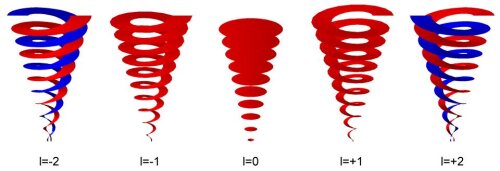Magnetism in materials
Magnetic materials rely on the ordering of the magnetic moments of their constituent atoms which leads to a specific response of the material when applying e.g. an external field. Many methods exist that can measure this macroscopic response of magnetic materials but often it is difficult to link this response to the microscopic ordering reality in a crystal. Making use of the atomic resolution capability of an electron microscope one could hope to visualise this magnetic ordering on a local scale. The interaction of the fast electrons with the microscopic magnetic fields inside a material however is relatively weak compared to the electrostatic interaction which is responsible for nearly all image contrast in a TEM.
Recently we developed so-called electron vortex probes which allow obtaining magnetic information in an EELS spectrum due to a change in excitation selection rules involving now the magnetic quantum number. The essence of such a vortex probe is that the wavefronts of the electron wave are helical instead of plane wave like as sketched in figure below, which leads to an angular momentum and a quantum of magnetic moment carried by the electron probe depending on the so-called topological charge l.
These vortex probes can be made to atomic size and can be scanned in a STEM setup leading to atomic resolution images. Combining this with EELS will lead to the detection of the magnetic state of individual atom colums. At present, this technique is being developed in the scope of an ERC starting Grant “Vortex”.
FIGURE LEGEND
Sketch of the wavefronts of electron vortex probes depending on the topological charge l. Note that for l=0 a typical spherical wave is obtained while for any other topological charge a helicoidal wavefront is present.
